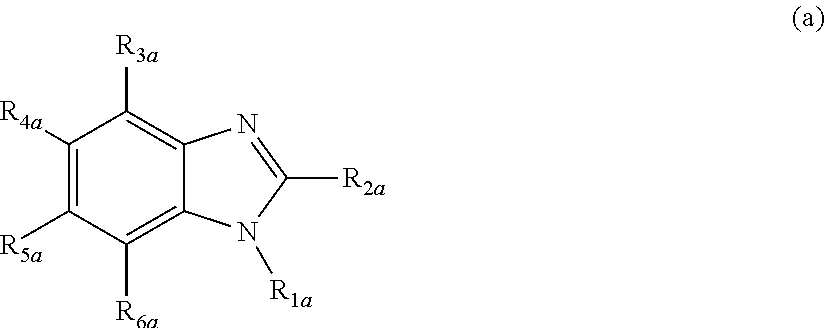Nitrogenous heterocyclic derivative and organic electroluminescence device making use of the same
a technology of nitrogen heterocyclic derivatives and organic electroluminescence devices, which is applied in the direction of discharge tube luminescnet screens, discharge tube/lamp details, organic chemistry, etc., can solve the problems of device not being used in practical applications and marked deterioration in properties, and achieve great light emission efficiency, great electron mobility, and great luminance
- Summary
- Abstract
- Description
- Claims
- Application Information
AI Technical Summary
Benefits of technology
Problems solved by technology
Method used
Image
Examples
synthesis example 1
(101) Synthesis of Intermediate 1
[0167]
[0168]Into a 1 liter three-necked flask, 35 g (0.1 mole) of dimethyl 2,5-dibromoterephthalate, 27 g (0.22 moles) of phenyl boronic acid, 5.7 g (5 mmole) of tetrakis(triphenylphosphine)palladium(0), 200 ml of toluene and a solution prepared by dissolving 32 g (0.3 moles) of sodium carbonate into 150 ml of water were placed under the stream of argon, and the resultant mixture was heated under the refluxing condition for 8 hours. After the reaction was completed, the organic layer was washed with water and dried with magnesium sulfate, and the solvent was removed by distillation using a rotary evaporator. The obtained crude crystals were recrystallized from ethanol, and 27 g of Intermediate 1 of the object compound was obtained (white crystals; the yield: 80%).
(1-2) Synthesis of Intermediate 2
[0169]
[0170]Into a 1 liter flask, 17 g (0.05 moles) of Intermediate 1 and 200 ml of 80% sulfuric acid were placed, and the obtained solution was heated at 18...
synthesis example 2
Synthesis of Compound (2)
[0181]
[0182]In accordance with the same procedures as those conducted in the synthesis of Compound (1) except that 2-phenyl-1-(4-bromophenyl)benzimidazole was used in place of 2-(4-bromophenyl)-1-phenylbenzimidazole, Compound (2) was obtained as a light yellow powder substance. The amount was 3.0 g (the yield: 70%). The obtained substance was identified to be Compound (2) by the measurement of the field desorption mass spectrum (FD-MS).
synthesis example 3
Synthesis of Compound (3)
[0183]
[0184]In accordance with the same procedures as those conducted in the synthesis of Compound (1) except that 5-bromo-1,2-diphenylbenzimidazole was used in place of 2-(4-bromophenyl)-1-phenylbenzimidazole, Compound (3) was obtained as a light yellow powder substance. The amount was 3.5 g (the yield: 82%). The obtained substance was identified to be Compound (3) by the measurement of the field desorption mass spectrum (FD-MS).
PUM
| Property | Measurement | Unit |
|---|---|---|
| voltage | aaaaa | aaaaa |
| luminance | aaaaa | aaaaa |
| transmittance | aaaaa | aaaaa |
Abstract
Description
Claims
Application Information
 Login to View More
Login to View More - R&D
- Intellectual Property
- Life Sciences
- Materials
- Tech Scout
- Unparalleled Data Quality
- Higher Quality Content
- 60% Fewer Hallucinations
Browse by: Latest US Patents, China's latest patents, Technical Efficacy Thesaurus, Application Domain, Technology Topic, Popular Technical Reports.
© 2025 PatSnap. All rights reserved.Legal|Privacy policy|Modern Slavery Act Transparency Statement|Sitemap|About US| Contact US: help@patsnap.com



